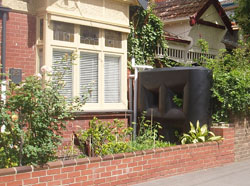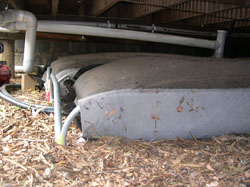resource library
Array
Residential rainwater tank

Under house rainwater storage vessel

Metal rainwater tank
Water Tank Reliability and Capacity Study
City of Ballarat
Published: 03 April 2012
Project Overview
The City of Ballarat in central western Victoria is a large and prosperous regional city. Unlike many other towns or cities that are founded and/or evolve on transport and trading routes, Ballarat was founded on gold.
As the ore deposits determined the location of the city rather than geographic features such as a river, the city has never had a strong reliable supply of water. It is currently served by a series of small catchments as well as the Goldfields Superpipe – bringing water from the Goulburn basin via Bendigo.
Ballarat has a growing population and as more people move there the demand for water will increase. The supply of water is a challenge for the City of Ballarat and the local water authority.
As part of its environmental education program and in an effort to reduce pressure on the existing potable water system, the City of Ballarat commissioned a study to quantify the catchment potential and reliability of rainwater tanks as an alternate source of water for new development and redevelopment areas. The study also explored the reduction in peak storm flows on the drainage system and consequential pollutant load reduction.
Drivers and Objectives
- To understand and quantify the impact of stand-alone rainwater tanks on water supply potential and reliability; pollutant reductions and peak flow reductions for individual allotments.
- To test and model the reliability of supply using a series of assumptions about tank sizes and user profiles within a typical household (based on the number of internal house connections and potential uses). This reliability was mapped against a typical average year using historical rainfall data for the period 1980-1999 and an extreme dry year using average rainfall data for the period 2000-2009.
- To quantify the potential reductions in potable water use in a typical household when using tank water in a variety of household uses.
- To model and predict the reductions in pollutant loads (total suspended solids, total nitrogen and total phosphorus) in the different tank size scenarios.
- To analyse the reduction in peak flow events using a typical household connection scenario (toilet and laundry connections) measured against differing tank sizes and outlet combinations.
Organisations
City of Ballarat (Responsible Council)
AECOM (Consultant)
Project Outcomes
The study found that a range of benefits can be gained for the community and for the individual landholder by installing the right sized tank to meet the needs of the households in Ballarat.
Rainwater tanks can provide good reliable water supply for toilet and laundry use except when the catchment or the storage is small i.e. smaller than 100m² or 1000 litres.
A significant amount of water for household use can be supplied by water held in a rainwater tank. This reduces the demand for high value/high cost potable water. Rainwater tanks can potentially reduce potable water demand by 20-40%.
The installation of rainwater tanks and capture of rain water will significantly reduce the loads of nitrogen and phosphorus being discharged into our receiving waters.
Water storage tanks can mitigate the effect of peak flow events up to the 1 in 2 year storm event.
Water storage tanks, when connected to toilet and laundry, can reduce onsite detention requirements by as much as 50%.
Lessons Learnt
On completion of the study, the City of Ballarat launched a media release earlier this year. The media release encouraged residents to install a rainwater tank and promoted the multiple benefits a tank can have on the community and environment.
The study is specific to the City of Ballarat and relates to the local rainfall patterns. However, the report does highlight some key benefits from the installation of rainwater tanks that may be relevant to other areas.
Councils can recommend the installation and use of rainwater tanks for domestic purposes. However, at present, there is no way to enforce the use of the rainwater tank once installed. It is up to the individual property owner to ensure the continual use of the tank. This is where council awareness raising campaigns and media releases are important to communicate the ongoing benefits of using rainwater tanks.
Project Cost
Less than $10,000
Timeframe
Delivered in 2011, three months to complete
Contact
Clearwater
03 9679 7835
